
In 2009, Robert Allgeyer retired his web page. His last page read:
Welcome to my now-obsolete home page. In early 2009, I removed my web site from the Internet. I have done enough of it, and reached the stage in my life where I want to spend time doing other things. I have left this page for a couple of extra months, so that occasional visitors can find it, before I finally remove everything.
I now live in Ormond Beach, Florida USA. Formerly, I was in Aptos, California USA. My name is prominent on the Internet due to my music fonts, fiction, essays, and travel comments. However, do not confuse me with the Midwestern jazz musician, the artist, the dancer, or any number of others with my same name.
So, I offered to host his free MusiQwik series of music fonts for him. Note that these are the final versions (5). Earlier versions (less than 5) should be replaced by this one. All his fonts and accompanying readme files zipped up.
 MusiSync displays a variety of note timings. The characters are useful for general decoration, or for learning a rhythm.
To access the glyphs in MusiSync, please use character palettes instead of the keyboard.
MusiSync displays a variety of note timings. The characters are useful for general decoration, or for learning a rhythm.
To access the glyphs in MusiSync, please use character palettes instead of the keyboard.
 MusiQwik and MusiQwik-Bold (2001 and 2008) are the basic workhorses. Allgeyer writes:
MusiQwik and MusiQwik-Bold (2001 and 2008) are the basic workhorses. Allgeyer writes: